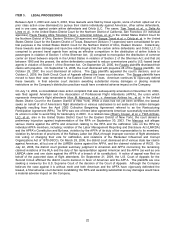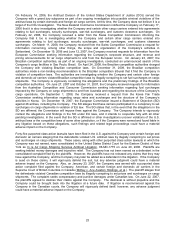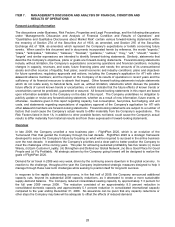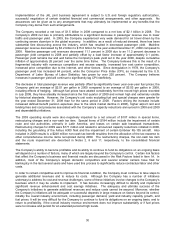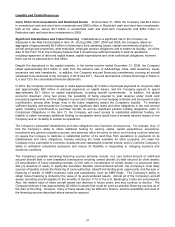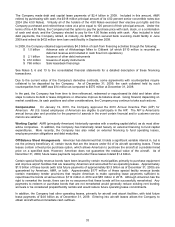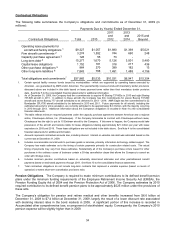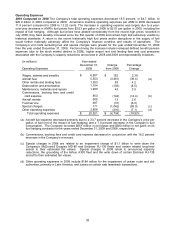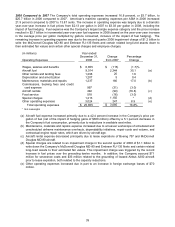American Airlines 2009 Annual Report Download - page 33
Download and view the complete annual report
Please find page 33 of the 2009 American Airlines annual report below. You can navigate through the pages in the report by either clicking on the pages listed below, or by using the keyword search tool below to find specific information within the annual report.
30
Implementation of the JAL joint business agreement is subject to U.S. and foreign regulatory authorization,
successful negotiation of certain detailed financial and commercial arrangements, and other approvals. No
assurances can be given as to any arrangements that may ultimately be implemented or any benefits that the
Company may derive from such arrangements.
The Company recorded a net loss of $1.5 billion in 2009 compared to a net loss of $2.1 billion in 2008. The
Company’s 2009 net loss is primarily attributable to a significant decrease in passenger revenue due to lower
traffic and passenger yield. In 2009, the Company experienced very weak demand for air travel driven by the
continuing severe downturn in the global economy. In addition, as a result of reduced demand, there has been
substantial fare discounting across the industry, which has resulted in decreased passenger yield. Mainline
passenger revenue decreased by $3.2 billion to $15.0 billion for the year ended December 31, 2009 compared to
2008. Mainline passenger unit revenues decreased 11.1 percent in 2009 due to an 11.2 percent decrease in
passenger yield compared to 2008 and partially offset by a load factor increase of approximately 0.1 points.
Passenger yield remains low and well below the Company’s peak yield set in the year 2000, despite cumulative
inflation of approximately 26 percent over the same time frame. The Company believes this is the result of a
fragmented industry with numerous competitors and excess capacity, increased low cost carrier competition,
increased price competition due to the internet, and other factors. Since deregulation in 1978, the Company’s
passenger yield has increased 64 percent, while the Consumer Price Index (CPI), as measured by the U.S.
Department of Labor Bureau of Labor Statistics, has grown by over 220 percent. The Company believes
increases in passenger yield will continue to significantly lag CPI indefinitely.
The decrease in total passenger revenue was partially offset by significantly lower year-over-year fuel prices; the
Company paid an average of $2.01 per gallon in 2009 compared to an average of $3.03 per gallon in 2008,
including effects of hedging. Although fuel prices have abated considerably from the record high prices recorded
in July 2008, they have steadily increased since the first quarter of 2009 and remain high and extremely volatile
by historical standards. However, the Company’s unit costs excluding fuel and special charges were greater for
the year ended December 31, 2009 than for the same period in 2008. Factors driving the increase include
increased defined benefit pension expenses (due to the stock market decline in 2008), higher airport rent and
landing fees and cost pressures associated with the Company’s capacity reductions announced in 2008 and 2009
and dependability initiatives.
The 2009 operating results were also negatively impacted by a net amount of $107 million in special items,
restructuring charges and a non-cash tax item. Special items of $184 million include the impairment of certain
route and slot authorities, primarily in Latin America, and losses on certain sale leaseback transactions.
Restructuring charges for 2009 were $171 million and related to announced capacity reductions initiated in 2008,
including the grounding of the Airbus A300 fleet and the impairment of certain Embraer RJ-135 aircraft. Also
included in 2009 results is a $248 million non-cash tax benefit resulting from the allocation of the tax expense to
other comprehensive income items recognized during 2009. The restructuring charges, the non-cash tax item
and the route impairment are described in Notes 2, 8 and 11, respectively, to the consolidated financial
statements.
The Company’s ability to become profitable and its ability to continue to fund its obligations on an ongoing basis
will depend on a number of factors, many of which are largely beyond the Company’s control. Certain risk factors
that affect the Company’s business and financial results are discussed in the Risk Factors listed in Item 1A. In
addition, most of the Company’s largest domestic competitors and several smaller carriers have filed for
bankruptcy in the last several years and have used this process to significantly reduce contractual labor and other
costs.
In order to remain competitive and to improve its financial condition, the Company must continue to take steps to
generate additional revenues and to reduce its costs. Although the Company has a number of initiatives
underway to address its cost and revenue challenges, some of these initiatives involve changes to the Company’s
business which it may be unable to implement. It has become increasingly difficult to identify and implement
significant revenue enhancement and cost savings initiatives. The adequacy and ultimate success of the
Company’s initiatives to generate additional revenues and reduce costs cannot be assured. Moreover, whether
the Company’s initiatives will be adequate or successful depends in large measure on factors beyond its control,
notably the overall industry environment, including passenger demand, yield and industry capacity growth, and
fuel prices. It will be very difficult for the Company to continue to fund its obligations on an ongoing basis, and to
return to profitability, if the overall industry revenue environment does not improve substantially or if fuel prices
were to increase and persist for an extended period at high levels.




